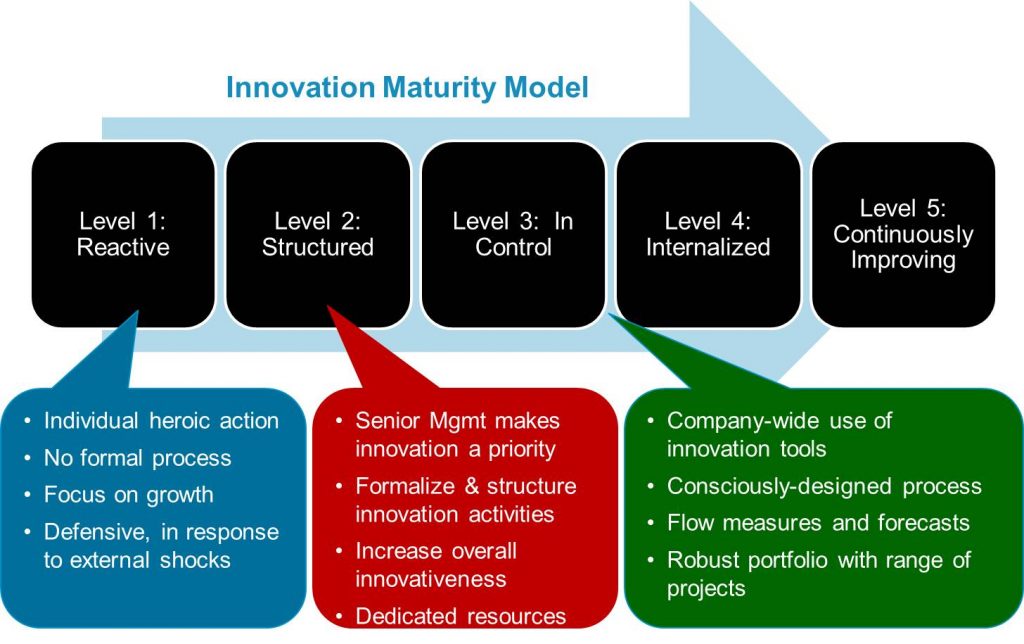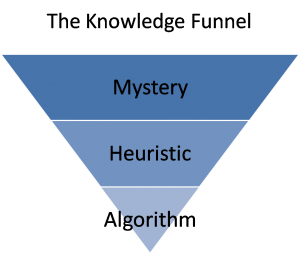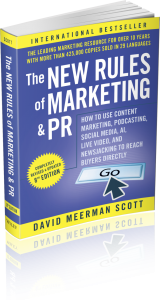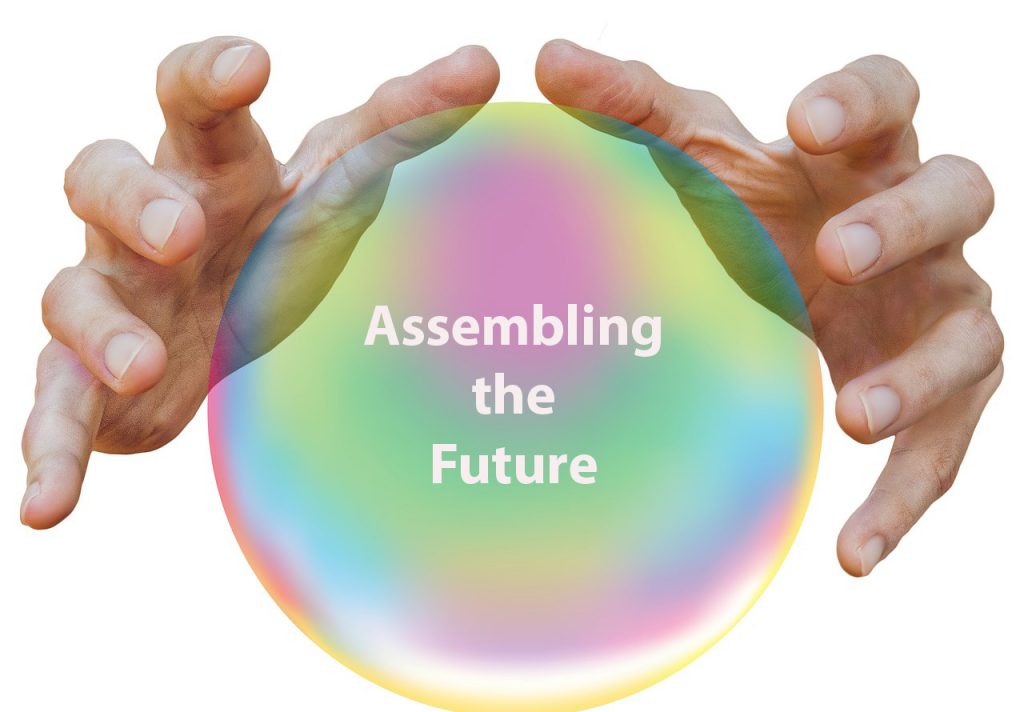
by Braden Kelley
Is our organization a productive place for creating innovation? How does our organization’s innovation capability compare to that of other organizations?
Almost every organization wants to know the answers to these two questions.
The only way to get better at innovation, is to first define what innovation means. Your organization must have a common language of innovation before you can measure a baseline of innovation maturity and begin elevating both your innovation capacity and capabilities.
My first book Stoking Your Innovation Bonfire, was created to help organizations create a common language of innovation and to understand how to overcome the barriers to innovation.
The Innovation Maturity Assessment
One of the free tools I created for purchasers of Stoking Your Innovation Bonfire, and for the global innovation community, was an innovation maturity assessment with available instant scoring at http://innovation.help.
My 50 question innovation audit measures each individual’s view of the organization’s innovation maturity across a number of different areas, including: culture, process, funding, collaboration, communications, etc.
When multiple individuals at the same organization complete the questionnaire, it is then possible to form an organizational view of the organization’s level of innovation maturity.
Each of the 50 questions is scored from 0-4 using this scale of question agreement:
- 0 – None
- 1 – A Little
- 2 – Partially
- 3 – Often
- 4 – Fully
To generate an innovation maturity score that is translated to the innovation maturity model as follows:
- 000-100 = Level 1 – Reactive
- 101-130 = Level 2 – Structured
- 131-150 = Level 3 – In Control
- 151-180 = Level 4 – Internalized
- 181-200 = Level 5 – Continuously Improving

Image adapted from the book Innovation Tournaments by Christian Terwiesch and Karl Ulrich
Innovation Maturity is Organization-Specific
The best way to understand the innovation maturity of your organization is to have a cross-functional group of individuals across your organization fill out the assessment and then collate and analyze the submissions. This allows us to make sense of the responses and to make recommendations of how the organization could evolve itself for the better. I do offer this as a service at http://innovation.help.
What Do the Numbers Say About the Average Level of Innovation Maturity?
To date, the innovation maturity assessment web application at http://innovation.help has gathered about 400 seemingly valid responses across a range of industries, geographies, organizations and job roles.
The average innovation maturity score to date is 102.91.
This places the current mean innovation maturity score at the border between Level 1 (Reactive) and Level 2 (Structured). This is not surprising.
Looking across the fifty (50) questions, the five HIGHEST scoring questions/statements are:
- We are constantly looking to improve as an organization (3.12)
- I know how to submit an innovation idea (2.83)
- Innovation is part of my job (2.81)
- It is okay to fail once in a while (2.74)
- Innovation is one of our core values (2.71)
The scores indicate that the typical level of agreement with the statements is “often” but not “always.”
Looking across the fifty (50) questions, the five LOWEST scoring questions/statements are:
- Six sigma is well understood and widely distributed in our organization (1.74)
- We have a web site for submitting innovation ideas (1.77)
- There is more than one funding source available for innovation ideas (1.79)
- We have a process for killing innovation projects (1.82)
- We are considered the partner of first resort for innovation ideas (1.83)
The scores indicate that the typical level of agreement with the statements is “partially.”
What does this tell us about the state of innovation maturity in the average organization?
The numbers gathered so far indicate that the state of innovation maturity in the average organization is low, nearly falling into the lowest level. This means that on average, our organizations are focused on growth, but often innovate defensively, in response to external shocks. Many organizations rely on individual, heroic action, lacking formal processes and coordinated approaches to innovation. But, organizations are trending towards greater prioritization of innovation by senior management, an introduction of dedicated resources and a more formal approach.
The highest scoring questions tell us that our organizations are still in the process of embedding a continuous improvement mindset. We also see signs that many people view innovation as a part of their job, regardless of whether they fill an innovation role. Often, people know how to submit an innovation idea. And, we can infer that an increasing number of organizations are becoming more comfortable with the notion of productive failure, and communicating the importance of innovation across the organization.
Finally, the lowest scoring questions show us that process improvement methodologies like six sigma haven’t penetrated as many organizations as one might think. This means that many organizations lack the experience of having already spread a shared improvement methodology across the organization, making the spread of an innovation language and methodologies a little more difficult. We also see an interesting disconnect around idea submission in the high and low scoring questions that seems to indicate that many organizations are using off-line idea submission. Zombie projects appear to be a problem for the average organization, along with getting innovation ideas funded as they emerge. And, many organizations struggle to engage partners across their value and supply chains in their innovation efforts.
Conclusion
While it is interesting to look at how your organization might compare to a broader average, it is often less actionable than creating that deeper understanding and analysis of the situation within your unique organization.
But no matter where your organization might lie now on the continuum of innovation maturity, it is important to see how many variables must be managed and influenced to build enhanced innovation capabilities. It is also important to understand the areas where your organization faces unique challenges compared to others – even in comparing different sites and/or functions within the same organization.
Creating a baseline and taking periodic measurements is crucial if you are serious about making progress in your level of innovation maturity. Make your own measurement and learn how to measure your organization’s innovation maturity more deeply at http://innovation.help.
No matter what level of innovation maturity your organization possesses today, by building a common language of innovation and by consciously working to improve across your greatest areas of opportunity, you can always increase your ability to achieve your innovation vision, strategy and goals.
Keep innovating!
This article originally appeared on the Edison365 Blog
![]() Sign up here to get Human-Centered Change & Innovation Weekly delivered to your inbox every week.
Sign up here to get Human-Centered Change & Innovation Weekly delivered to your inbox every week.













 The knowledge funnel is a useful concept learned from Roger Martin in the Design of Business. The concept highlights how any new area creating information (and hopefully knowledge) starts very much as a mystery, but as our understanding of the topic area increases, we begin to identify heuristics and make sense of it. For me, this is where we begin to move from data and information to knowledge, and then as our knowledge increases we are able to codify this knowledge into algorithms.
The knowledge funnel is a useful concept learned from Roger Martin in the Design of Business. The concept highlights how any new area creating information (and hopefully knowledge) starts very much as a mystery, but as our understanding of the topic area increases, we begin to identify heuristics and make sense of it. For me, this is where we begin to move from data and information to knowledge, and then as our knowledge increases we are able to codify this knowledge into algorithms.


